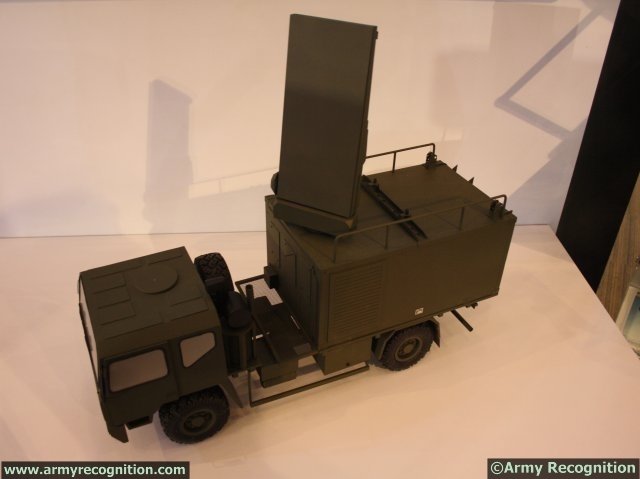Breaking news
At IndoDefence 2014 SAAB displays the Artillery Hunting Radar "ARTHUR" mobile radar system.
| a | |||||
 |
|||||
IndoDefence 2014 Official Online Show Daily News International Tri-Service Defence Exhibition Jakarta , Indonesia 5 - 8 November 2014 |
|||||
SAAB at IndoDefence 2014 |
|||||
| Friday, November 7, 2014 11:04 PM | |||||
| At IndoDefence 2014 SAAB displays the Artillery Hunting Radar "ARTHUR" mobile radar system | |||||
|
At IndoDefence 2014, SAAB is displaying its Artillery Hunting Radar "ARTHUR"
mobile passive electronically scanned array C-Band radar system. ARTHUR
is a highly mobile weapon locating system, tactically deployed close to
the forward line of own troops. |
|||||
 SAAB Artillery Hunting Radar "ARTHUR"
mobile passive electronically scanned array C-Band radar system
scale model at IndoDefence 2014
SAAB Artillery Hunting Radar "ARTHUR"
mobile passive electronically scanned array C-Band radar system
scale model at IndoDefence 2014 |
|||||
Based on these calculations priorities are made and directions are provided
for effective counter-battery fire. In fire control mode, ARTHUR will
track the projectiles of own fire and extrapolate the points of impact.
In Sense & Warn mode, extrapolation of points of impact of incoming
fire will trigger timely warning to own troops. The ARTHUR radar continuously searches the horizon and immediately tracks projectiles early in the trajectory. Gun, mortar or rocket projectiles are automatically classified and correctly associated to batteries. Within seconds less than 4s ARTHUR will send a call for message to your own artillery command and control system, effectively coordinating precise counter-battery. ARTHUR has an instrumented range of 20, 30, 40 or 60 km. It operates over a nominal sector of up to an 120°. The sustained maximum capacity for detection, tracking, classi? cation and impact calculation is well over 100 targets per minute. The ARTHUR control mode is used to register the points of impact of own artillery . The mode is selected manually or automatically by an incoming data message from the command and control system. ARTHUR tracks and calculates mean positions of own points of impact and automatically sends a message back containing precise correction data for adjustment. ARTHUR extrapolates – in real time – the trajectory of all incoming projectiles to determine the point of impact. Should the calculated impact reside within defined Critical Friendly Zones (CFZ), ARTHUR will trigger timely warning. Thereby both force and asset protection is assured. Launched in 1999, ARTHUR is operational in twelve countries, among them Norway, Sweden, the Czech Republic, South Korea, Spain, Italy, Greece and the UK. The system has been proven in wartime service with the British forces in the second Gulf War in 2003 and served with British and other forces in operations in Afghanistan and Iraq, where it was used in 24/7 combat operations. Its recorded inherent availability is more than 99.9%. |
|||||
 SAAB Artillery
Hunting Radar "ARTHUR" mobile passive electronically scanned
array C-Band radar system scale model at IndoDefence 2014
SAAB Artillery
Hunting Radar "ARTHUR" mobile passive electronically scanned
array C-Band radar system scale model at IndoDefence 2014 |
|||||
| ARTHUR
is designed with unique transportability and ease of operation in mind.
The entire system is installed in an ISO-cornered shelter weighing only
4500 kg. This means it can be carried by any single cross-country truck
or tracked vehicle with a 5-tonne payload capacity. It also implies high
speed for on-road transport as well as high offroad mobility.
The system can be airlifted by a single C-130 using standard equipment for container handling. With larger aircraft, such as the IL-76, C-17 or A400M, all versions can be transported as drive-on/drive-off cargo. Designed for a high degree of automation, two operators/soldiers can perform both deployment and teardown of ARTHUR in less than two minutes. ARTHUR will itself be a high-priority target. Survival limits the useful operating time at any single deployment site to 10-30 minutes, depending on the threat level. Deploying in only two minutes maximises the useful operating time at a given physical location without jeopardising system survival. The antenna aperture consists of 48 slotted ridge waveguides, effectively implementing a built-in functional redundancy. Should the antenna be partially hit by small-arms or shrapnel, remaining waveguides will stay functional and offer true graceful functional degradation. The system has low infrared (IR) and electronic warfare (EW) signatures, which makes it harder to detect and hit with thermal or radar-seeking weapons. |
|||||

























